Analyzing Foreign Direct Investment's Impact on the UK Economy
VerifiedAdded on 2021/05/29
|21
|6033
|329
Report
AI Summary
This report investigates the relationship between Foreign Direct Investment (FDI) and the economic growth of the United Kingdom. It begins with an introduction that defines FDI and its significance, distinguishing it from foreign portfolio investment. The report explores the components of FDI and highlights the role of FDI in increasing GDP and tax revenue. The study poses research questions about the evolution of FDI in the UK and the strength of its relationship with economic growth. It reviews existing literature on the impact of FDI, including its contributions to technology transfer, employment development, and the importance of host country conditions like financial systems and labor. The methodology involves regression analysis using data from reputable sources like the IMF and World Fact Book to examine the correlation between FDI and economic growth, considering control variables such as debt-to-GDP ratio and unemployment rate. The report aims to identify the nature of FDI involvement in the UK and to assess the relationship between FDI and economic growth rates. Findings are expected to support existing research on the influence of FDI in host countries, providing insights into the UK's economic landscape.
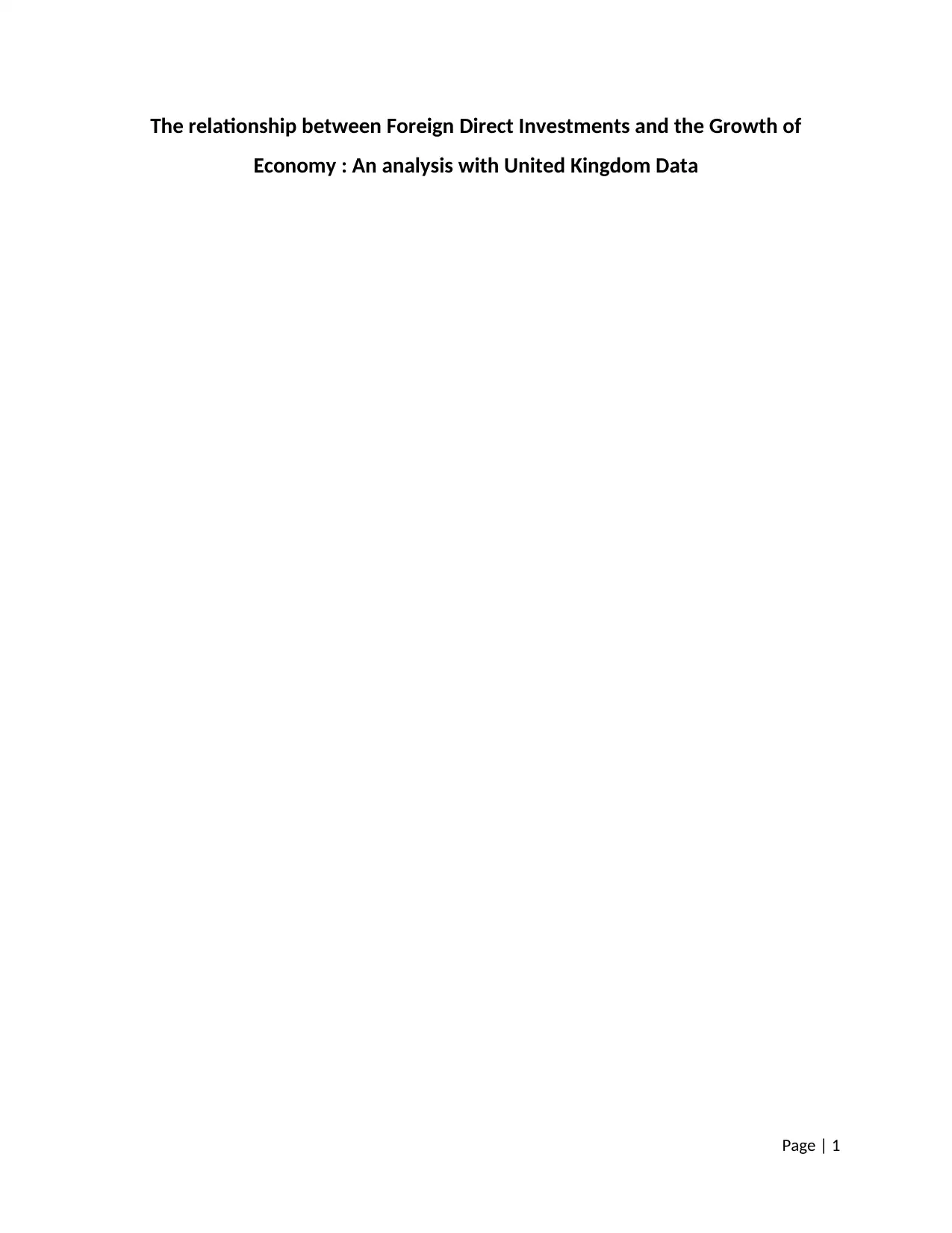
The relationship between Foreign Direct Investments and the Growth of
Economy : An analysis with United Kingdom Data
Page | 1
Economy : An analysis with United Kingdom Data
Page | 1
Paraphrase This Document
Need a fresh take? Get an instant paraphrase of this document with our AI Paraphraser

Table of Content
Page | 2
Page | 2
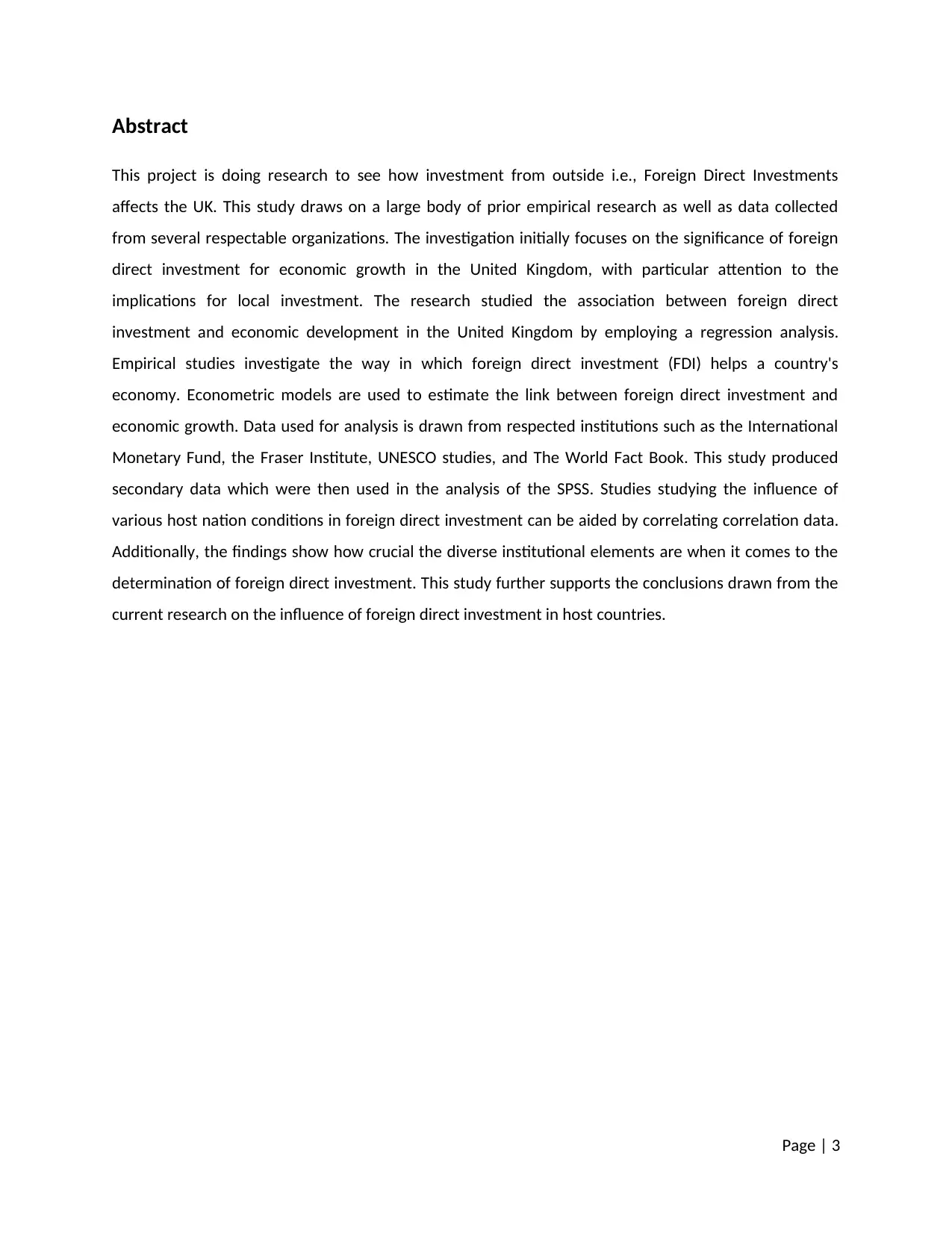
Abstract
This project is doing research to see how investment from outside i.e., Foreign Direct Investments
affects the UK. This study draws on a large body of prior empirical research as well as data collected
from several respectable organizations. The investigation initially focuses on the significance of foreign
direct investment for economic growth in the United Kingdom, with particular attention to the
implications for local investment. The research studied the association between foreign direct
investment and economic development in the United Kingdom by employing a regression analysis.
Empirical studies investigate the way in which foreign direct investment (FDI) helps a country's
economy. Econometric models are used to estimate the link between foreign direct investment and
economic growth. Data used for analysis is drawn from respected institutions such as the International
Monetary Fund, the Fraser Institute, UNESCO studies, and The World Fact Book. This study produced
secondary data which were then used in the analysis of the SPSS. Studies studying the influence of
various host nation conditions in foreign direct investment can be aided by correlating correlation data.
Additionally, the findings show how crucial the diverse institutional elements are when it comes to the
determination of foreign direct investment. This study further supports the conclusions drawn from the
current research on the influence of foreign direct investment in host countries.
Page | 3
This project is doing research to see how investment from outside i.e., Foreign Direct Investments
affects the UK. This study draws on a large body of prior empirical research as well as data collected
from several respectable organizations. The investigation initially focuses on the significance of foreign
direct investment for economic growth in the United Kingdom, with particular attention to the
implications for local investment. The research studied the association between foreign direct
investment and economic development in the United Kingdom by employing a regression analysis.
Empirical studies investigate the way in which foreign direct investment (FDI) helps a country's
economy. Econometric models are used to estimate the link between foreign direct investment and
economic growth. Data used for analysis is drawn from respected institutions such as the International
Monetary Fund, the Fraser Institute, UNESCO studies, and The World Fact Book. This study produced
secondary data which were then used in the analysis of the SPSS. Studies studying the influence of
various host nation conditions in foreign direct investment can be aided by correlating correlation data.
Additionally, the findings show how crucial the diverse institutional elements are when it comes to the
determination of foreign direct investment. This study further supports the conclusions drawn from the
current research on the influence of foreign direct investment in host countries.
Page | 3
⊘ This is a preview!⊘
Do you want full access?
Subscribe today to unlock all pages.

Trusted by 1+ million students worldwide

1.0 Introduction
1.1 Background of the Study
FDI is a foundation on which many economies stand, providing them with financial insulation
against a boom-bust cycle that is common in capitalist economies. Investing is also necessary
for the development and expansion of most economies. Carkovic and Levine state: (2002). The
investment made in a nation by another (typically firms) that frequently involves the acquisition
or establishment of assets, purchase of interests, and development of businesses that can
create revenue is referred to as foreign direct investment. An investor either takes charge of
the business or buys the business. Another thing investors may do is own or control specific
industrial technologies, crucial manufacturing inputs, or any relevant human resources. They
also get more than 10% of the voting power in the organization. But this will differ among
countries. Separating foreign direct investment from foreign portfolio investment is crucial at
this point since they are frequently conflated. According to Bruno (2016), portfolio investment
by nationals of one country to the securities market of another country is referred to as foreign
portfolio investment. It entails buying shares and bonds in another country's financial market.
Investing in foreign direct investment is important for the economy of any country. The (Gross
Domestic Product) GDP of a country is heavily influenced by direct foreign investment since it is
the primary contributor to the economy's overall worth. GDP (the total sum of all final goods
and services produced in a country within a certain time period) is defined as the gross
investment made in the country. To understand FDI, one must look at net foreign investment
less outflow of capital (money exiting the country)." When it comes to foreign direct
investment, there are three components involved: short-term capital, long-term capital, and
equity capital. Recent empirical data has proven that foreign direct investment benefits the
growth of emerging economies and those transitioning to developed ones. When FDI increases,
so does the economy. The increase in capital inflow and the rise in tax revenue for the host
government cause this. FDI added over 300 billion pounds in income throughout the year 2000,
according to Aswathappa et al. The acquisition of foreign direct investment (FDI) is one of the
most significant sources of revenue in industrialized nations. Foreign direct investment is aimed
Page | 4
1.1 Background of the Study
FDI is a foundation on which many economies stand, providing them with financial insulation
against a boom-bust cycle that is common in capitalist economies. Investing is also necessary
for the development and expansion of most economies. Carkovic and Levine state: (2002). The
investment made in a nation by another (typically firms) that frequently involves the acquisition
or establishment of assets, purchase of interests, and development of businesses that can
create revenue is referred to as foreign direct investment. An investor either takes charge of
the business or buys the business. Another thing investors may do is own or control specific
industrial technologies, crucial manufacturing inputs, or any relevant human resources. They
also get more than 10% of the voting power in the organization. But this will differ among
countries. Separating foreign direct investment from foreign portfolio investment is crucial at
this point since they are frequently conflated. According to Bruno (2016), portfolio investment
by nationals of one country to the securities market of another country is referred to as foreign
portfolio investment. It entails buying shares and bonds in another country's financial market.
Investing in foreign direct investment is important for the economy of any country. The (Gross
Domestic Product) GDP of a country is heavily influenced by direct foreign investment since it is
the primary contributor to the economy's overall worth. GDP (the total sum of all final goods
and services produced in a country within a certain time period) is defined as the gross
investment made in the country. To understand FDI, one must look at net foreign investment
less outflow of capital (money exiting the country)." When it comes to foreign direct
investment, there are three components involved: short-term capital, long-term capital, and
equity capital. Recent empirical data has proven that foreign direct investment benefits the
growth of emerging economies and those transitioning to developed ones. When FDI increases,
so does the economy. The increase in capital inflow and the rise in tax revenue for the host
government cause this. FDI added over 300 billion pounds in income throughout the year 2000,
according to Aswathappa et al. The acquisition of foreign direct investment (FDI) is one of the
most significant sources of revenue in industrialized nations. Foreign direct investment is aimed
Page | 4
Paraphrase This Document
Need a fresh take? Get an instant paraphrase of this document with our AI Paraphraser
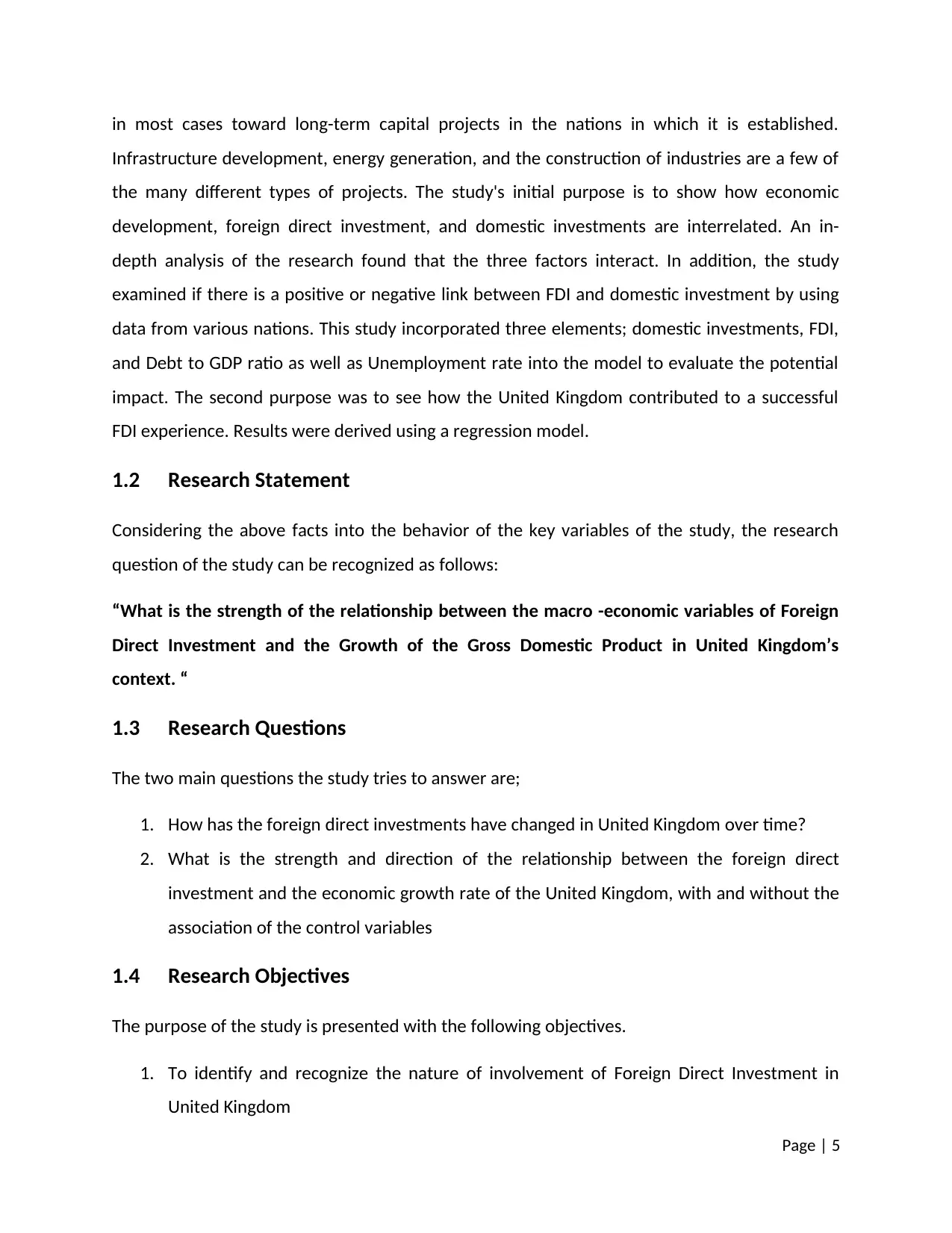
in most cases toward long-term capital projects in the nations in which it is established.
Infrastructure development, energy generation, and the construction of industries are a few of
the many different types of projects. The study's initial purpose is to show how economic
development, foreign direct investment, and domestic investments are interrelated. An in-
depth analysis of the research found that the three factors interact. In addition, the study
examined if there is a positive or negative link between FDI and domestic investment by using
data from various nations. This study incorporated three elements; domestic investments, FDI,
and Debt to GDP ratio as well as Unemployment rate into the model to evaluate the potential
impact. The second purpose was to see how the United Kingdom contributed to a successful
FDI experience. Results were derived using a regression model.
1.2 Research Statement
Considering the above facts into the behavior of the key variables of the study, the research
question of the study can be recognized as follows:
“What is the strength of the relationship between the macro -economic variables of Foreign
Direct Investment and the Growth of the Gross Domestic Product in United Kingdom’s
context. “
1.3 Research Questions
The two main questions the study tries to answer are;
1. How has the foreign direct investments have changed in United Kingdom over time?
2. What is the strength and direction of the relationship between the foreign direct
investment and the economic growth rate of the United Kingdom, with and without the
association of the control variables
1.4 Research Objectives
The purpose of the study is presented with the following objectives.
1. To identify and recognize the nature of involvement of Foreign Direct Investment in
United Kingdom
Page | 5
Infrastructure development, energy generation, and the construction of industries are a few of
the many different types of projects. The study's initial purpose is to show how economic
development, foreign direct investment, and domestic investments are interrelated. An in-
depth analysis of the research found that the three factors interact. In addition, the study
examined if there is a positive or negative link between FDI and domestic investment by using
data from various nations. This study incorporated three elements; domestic investments, FDI,
and Debt to GDP ratio as well as Unemployment rate into the model to evaluate the potential
impact. The second purpose was to see how the United Kingdom contributed to a successful
FDI experience. Results were derived using a regression model.
1.2 Research Statement
Considering the above facts into the behavior of the key variables of the study, the research
question of the study can be recognized as follows:
“What is the strength of the relationship between the macro -economic variables of Foreign
Direct Investment and the Growth of the Gross Domestic Product in United Kingdom’s
context. “
1.3 Research Questions
The two main questions the study tries to answer are;
1. How has the foreign direct investments have changed in United Kingdom over time?
2. What is the strength and direction of the relationship between the foreign direct
investment and the economic growth rate of the United Kingdom, with and without the
association of the control variables
1.4 Research Objectives
The purpose of the study is presented with the following objectives.
1. To identify and recognize the nature of involvement of Foreign Direct Investment in
United Kingdom
Page | 5

2. To examine the relationship between the foreign direct investment and the economic
growth rate in United Kingdom
Page | 6
growth rate in United Kingdom
Page | 6
⊘ This is a preview!⊘
Do you want full access?
Subscribe today to unlock all pages.

Trusted by 1+ million students worldwide
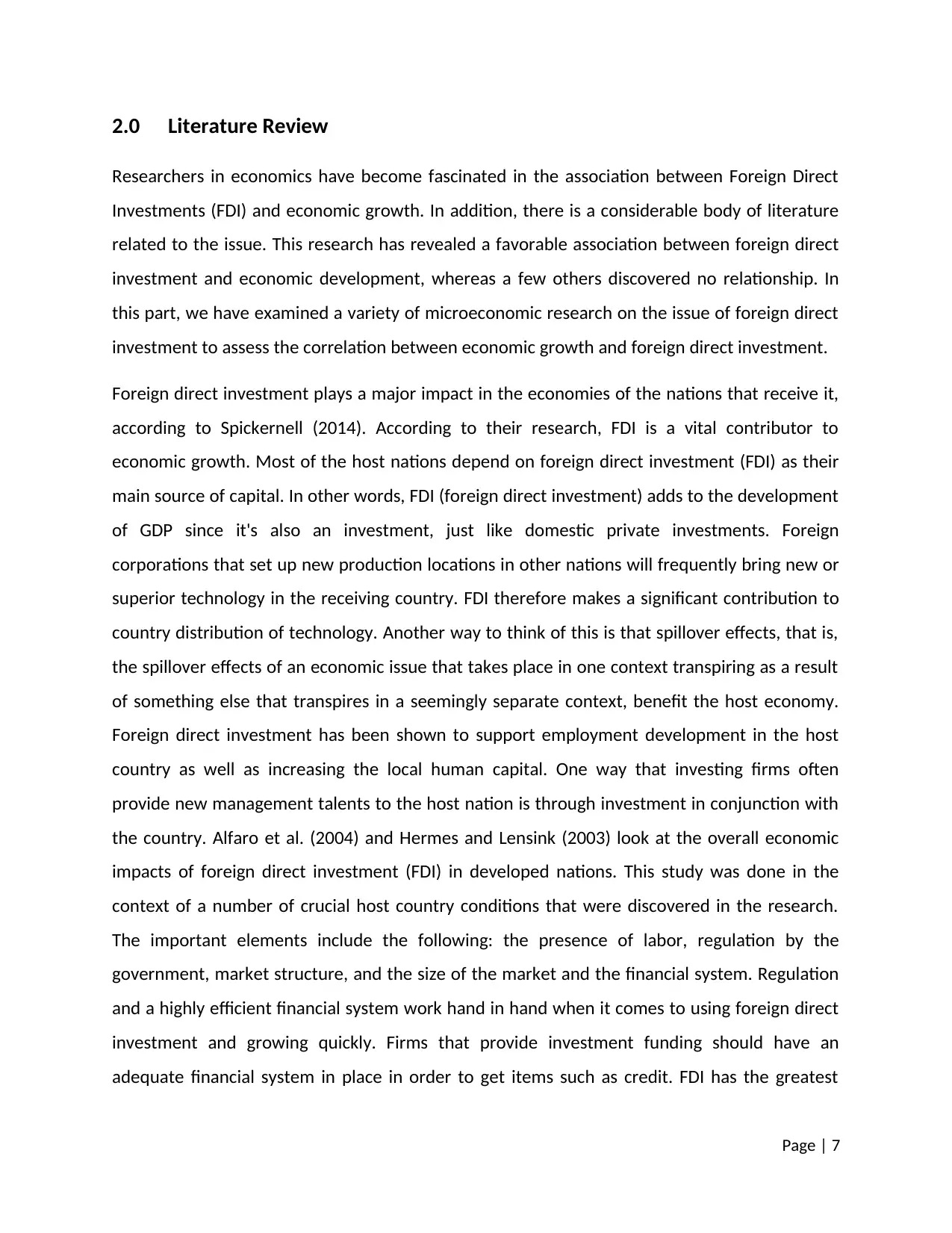
2.0 Literature Review
Researchers in economics have become fascinated in the association between Foreign Direct
Investments (FDI) and economic growth. In addition, there is a considerable body of literature
related to the issue. This research has revealed a favorable association between foreign direct
investment and economic development, whereas a few others discovered no relationship. In
this part, we have examined a variety of microeconomic research on the issue of foreign direct
investment to assess the correlation between economic growth and foreign direct investment.
Foreign direct investment plays a major impact in the economies of the nations that receive it,
according to Spickernell (2014). According to their research, FDI is a vital contributor to
economic growth. Most of the host nations depend on foreign direct investment (FDI) as their
main source of capital. In other words, FDI (foreign direct investment) adds to the development
of GDP since it's also an investment, just like domestic private investments. Foreign
corporations that set up new production locations in other nations will frequently bring new or
superior technology in the receiving country. FDI therefore makes a significant contribution to
country distribution of technology. Another way to think of this is that spillover effects, that is,
the spillover effects of an economic issue that takes place in one context transpiring as a result
of something else that transpires in a seemingly separate context, benefit the host economy.
Foreign direct investment has been shown to support employment development in the host
country as well as increasing the local human capital. One way that investing firms often
provide new management talents to the host nation is through investment in conjunction with
the country. Alfaro et al. (2004) and Hermes and Lensink (2003) look at the overall economic
impacts of foreign direct investment (FDI) in developed nations. This study was done in the
context of a number of crucial host country conditions that were discovered in the research.
The important elements include the following: the presence of labor, regulation by the
government, market structure, and the size of the market and the financial system. Regulation
and a highly efficient financial system work hand in hand when it comes to using foreign direct
investment and growing quickly. Firms that provide investment funding should have an
adequate financial system in place in order to get items such as credit. FDI has the greatest
Page | 7
Researchers in economics have become fascinated in the association between Foreign Direct
Investments (FDI) and economic growth. In addition, there is a considerable body of literature
related to the issue. This research has revealed a favorable association between foreign direct
investment and economic development, whereas a few others discovered no relationship. In
this part, we have examined a variety of microeconomic research on the issue of foreign direct
investment to assess the correlation between economic growth and foreign direct investment.
Foreign direct investment plays a major impact in the economies of the nations that receive it,
according to Spickernell (2014). According to their research, FDI is a vital contributor to
economic growth. Most of the host nations depend on foreign direct investment (FDI) as their
main source of capital. In other words, FDI (foreign direct investment) adds to the development
of GDP since it's also an investment, just like domestic private investments. Foreign
corporations that set up new production locations in other nations will frequently bring new or
superior technology in the receiving country. FDI therefore makes a significant contribution to
country distribution of technology. Another way to think of this is that spillover effects, that is,
the spillover effects of an economic issue that takes place in one context transpiring as a result
of something else that transpires in a seemingly separate context, benefit the host economy.
Foreign direct investment has been shown to support employment development in the host
country as well as increasing the local human capital. One way that investing firms often
provide new management talents to the host nation is through investment in conjunction with
the country. Alfaro et al. (2004) and Hermes and Lensink (2003) look at the overall economic
impacts of foreign direct investment (FDI) in developed nations. This study was done in the
context of a number of crucial host country conditions that were discovered in the research.
The important elements include the following: the presence of labor, regulation by the
government, market structure, and the size of the market and the financial system. Regulation
and a highly efficient financial system work hand in hand when it comes to using foreign direct
investment and growing quickly. Firms that provide investment funding should have an
adequate financial system in place in order to get items such as credit. FDI has the greatest
Page | 7
Paraphrase This Document
Need a fresh take? Get an instant paraphrase of this document with our AI Paraphraser
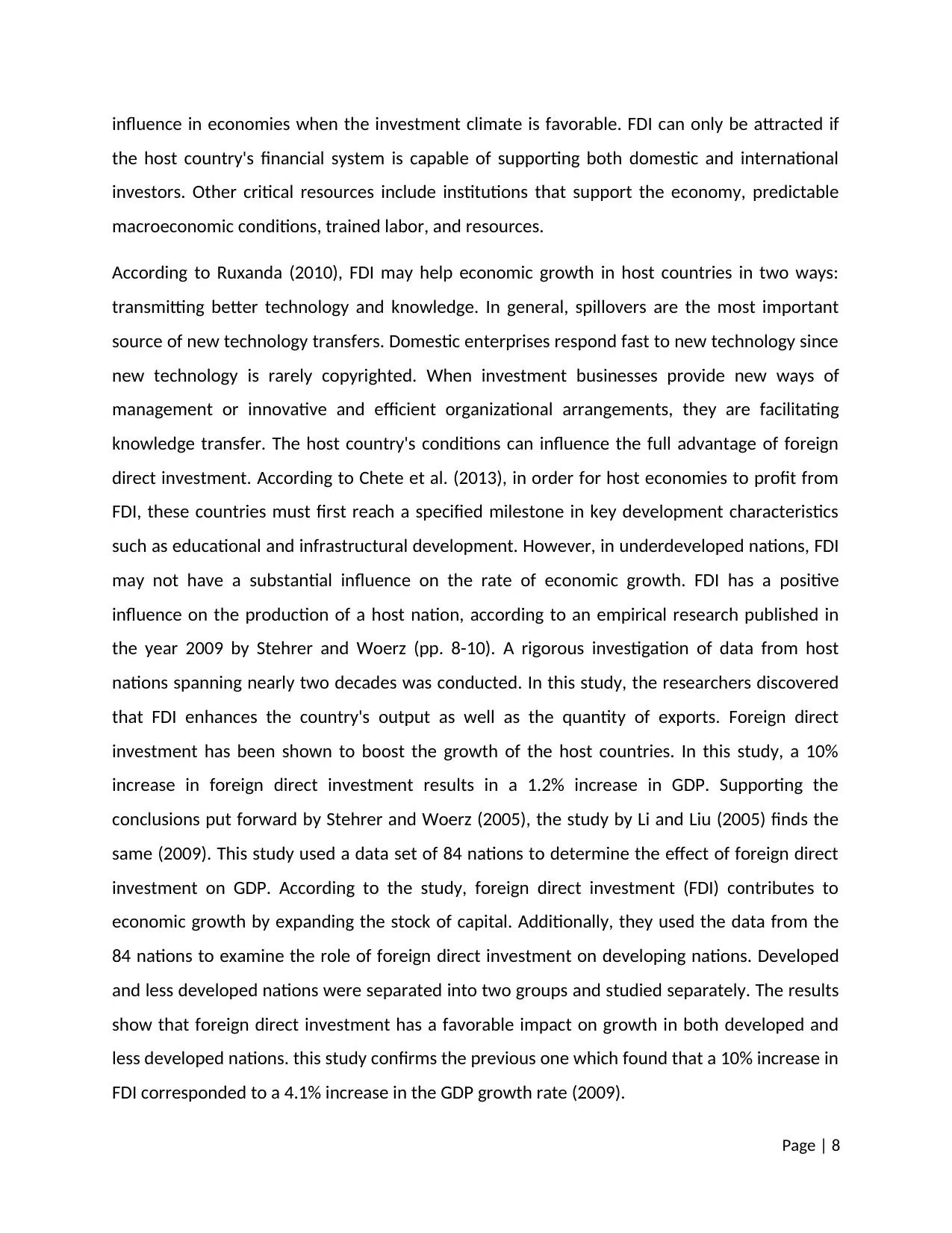
influence in economies when the investment climate is favorable. FDI can only be attracted if
the host country's financial system is capable of supporting both domestic and international
investors. Other critical resources include institutions that support the economy, predictable
macroeconomic conditions, trained labor, and resources.
According to Ruxanda (2010), FDI may help economic growth in host countries in two ways:
transmitting better technology and knowledge. In general, spillovers are the most important
source of new technology transfers. Domestic enterprises respond fast to new technology since
new technology is rarely copyrighted. When investment businesses provide new ways of
management or innovative and efficient organizational arrangements, they are facilitating
knowledge transfer. The host country's conditions can influence the full advantage of foreign
direct investment. According to Chete et al. (2013), in order for host economies to profit from
FDI, these countries must first reach a specified milestone in key development characteristics
such as educational and infrastructural development. However, in underdeveloped nations, FDI
may not have a substantial influence on the rate of economic growth. FDI has a positive
influence on the production of a host nation, according to an empirical research published in
the year 2009 by Stehrer and Woerz (pp. 8-10). A rigorous investigation of data from host
nations spanning nearly two decades was conducted. In this study, the researchers discovered
that FDI enhances the country's output as well as the quantity of exports. Foreign direct
investment has been shown to boost the growth of the host countries. In this study, a 10%
increase in foreign direct investment results in a 1.2% increase in GDP. Supporting the
conclusions put forward by Stehrer and Woerz (2005), the study by Li and Liu (2005) finds the
same (2009). This study used a data set of 84 nations to determine the effect of foreign direct
investment on GDP. According to the study, foreign direct investment (FDI) contributes to
economic growth by expanding the stock of capital. Additionally, they used the data from the
84 nations to examine the role of foreign direct investment on developing nations. Developed
and less developed nations were separated into two groups and studied separately. The results
show that foreign direct investment has a favorable impact on growth in both developed and
less developed nations. this study confirms the previous one which found that a 10% increase in
FDI corresponded to a 4.1% increase in the GDP growth rate (2009).
Page | 8
the host country's financial system is capable of supporting both domestic and international
investors. Other critical resources include institutions that support the economy, predictable
macroeconomic conditions, trained labor, and resources.
According to Ruxanda (2010), FDI may help economic growth in host countries in two ways:
transmitting better technology and knowledge. In general, spillovers are the most important
source of new technology transfers. Domestic enterprises respond fast to new technology since
new technology is rarely copyrighted. When investment businesses provide new ways of
management or innovative and efficient organizational arrangements, they are facilitating
knowledge transfer. The host country's conditions can influence the full advantage of foreign
direct investment. According to Chete et al. (2013), in order for host economies to profit from
FDI, these countries must first reach a specified milestone in key development characteristics
such as educational and infrastructural development. However, in underdeveloped nations, FDI
may not have a substantial influence on the rate of economic growth. FDI has a positive
influence on the production of a host nation, according to an empirical research published in
the year 2009 by Stehrer and Woerz (pp. 8-10). A rigorous investigation of data from host
nations spanning nearly two decades was conducted. In this study, the researchers discovered
that FDI enhances the country's output as well as the quantity of exports. Foreign direct
investment has been shown to boost the growth of the host countries. In this study, a 10%
increase in foreign direct investment results in a 1.2% increase in GDP. Supporting the
conclusions put forward by Stehrer and Woerz (2005), the study by Li and Liu (2005) finds the
same (2009). This study used a data set of 84 nations to determine the effect of foreign direct
investment on GDP. According to the study, foreign direct investment (FDI) contributes to
economic growth by expanding the stock of capital. Additionally, they used the data from the
84 nations to examine the role of foreign direct investment on developing nations. Developed
and less developed nations were separated into two groups and studied separately. The results
show that foreign direct investment has a favorable impact on growth in both developed and
less developed nations. this study confirms the previous one which found that a 10% increase in
FDI corresponded to a 4.1% increase in the GDP growth rate (2009).
Page | 8

Ruxanda (2010) points to the results of numerous other research which conclude that foreign
direct investment is an essential ingredient in a country's economic success. The transmission
of new information, manufacturing skills, new technologies, and the manufacture of new items,
all stemming from foreign direct investment, supports economic growth. As Ruxanda (2010)
notes, FDI may achieve greater results when the recipient nations have enough access to and
use of new and used technology. To help them simplify imports and exports, industrialized
nations should be more willing to adapt and utilize new technology. Foreign direct investment
may boost the local enterprises in the host countries by boosting the flow of technology to such
businesses. Copying, learning from the much-advanced overseas subsidiaries, competitiveness,
interconnections, and training are ways in which spillover might occur. Entry of foreign
enterprises with superior technology has spillover effects in the industry. In order to compete,
these small businesses must keep up with technological advancements. Firms attempt to
develop workers' capabilities via training.
Lauren (2008) Research on the correlation between foreign direct investment and the GDP of
the nations analyzed has yet to provide favorable results. a correlation research to uncover the
association between FDI and GDP was conducted by Borensztein (1998). This research
investigated the growth and development of 69 nations throughout different time intervals. To
investigate FDI and GDP, cross-country regression analysis was used. FDI has the potential to
increase GDP growth assuming certain criteria are met (Borensztein, 1998). The country hosting
the tournament must have a plentiful supply of human capital. Furthermore, he advocated that
host nations should have a supply of trained labor ready in order to meet future needs. Several
other studies have shown that direct foreign investment is more efficient than local investment
in increasing economic growth. The results of this research, together with previously studied
research, strengthen the idea that FDI can contribute to technology transfer.
FDI has been seen as a means to foster economic growth since it allows investors to embrace
the finest managerial techniques, new technology, or highly skilled workers. Increasing
productivity for the host country is also helped by these variables. Foreign direct investment
increases inbound investment in the host country for investors. Also, it supports domestic
resources in the nations where it is implemented. Dunning (2012) contends that in addition to
Page | 9
direct investment is an essential ingredient in a country's economic success. The transmission
of new information, manufacturing skills, new technologies, and the manufacture of new items,
all stemming from foreign direct investment, supports economic growth. As Ruxanda (2010)
notes, FDI may achieve greater results when the recipient nations have enough access to and
use of new and used technology. To help them simplify imports and exports, industrialized
nations should be more willing to adapt and utilize new technology. Foreign direct investment
may boost the local enterprises in the host countries by boosting the flow of technology to such
businesses. Copying, learning from the much-advanced overseas subsidiaries, competitiveness,
interconnections, and training are ways in which spillover might occur. Entry of foreign
enterprises with superior technology has spillover effects in the industry. In order to compete,
these small businesses must keep up with technological advancements. Firms attempt to
develop workers' capabilities via training.
Lauren (2008) Research on the correlation between foreign direct investment and the GDP of
the nations analyzed has yet to provide favorable results. a correlation research to uncover the
association between FDI and GDP was conducted by Borensztein (1998). This research
investigated the growth and development of 69 nations throughout different time intervals. To
investigate FDI and GDP, cross-country regression analysis was used. FDI has the potential to
increase GDP growth assuming certain criteria are met (Borensztein, 1998). The country hosting
the tournament must have a plentiful supply of human capital. Furthermore, he advocated that
host nations should have a supply of trained labor ready in order to meet future needs. Several
other studies have shown that direct foreign investment is more efficient than local investment
in increasing economic growth. The results of this research, together with previously studied
research, strengthen the idea that FDI can contribute to technology transfer.
FDI has been seen as a means to foster economic growth since it allows investors to embrace
the finest managerial techniques, new technology, or highly skilled workers. Increasing
productivity for the host country is also helped by these variables. Foreign direct investment
increases inbound investment in the host country for investors. Also, it supports domestic
resources in the nations where it is implemented. Dunning (2012) contends that in addition to
Page | 9
⊘ This is a preview!⊘
Do you want full access?
Subscribe today to unlock all pages.

Trusted by 1+ million students worldwide
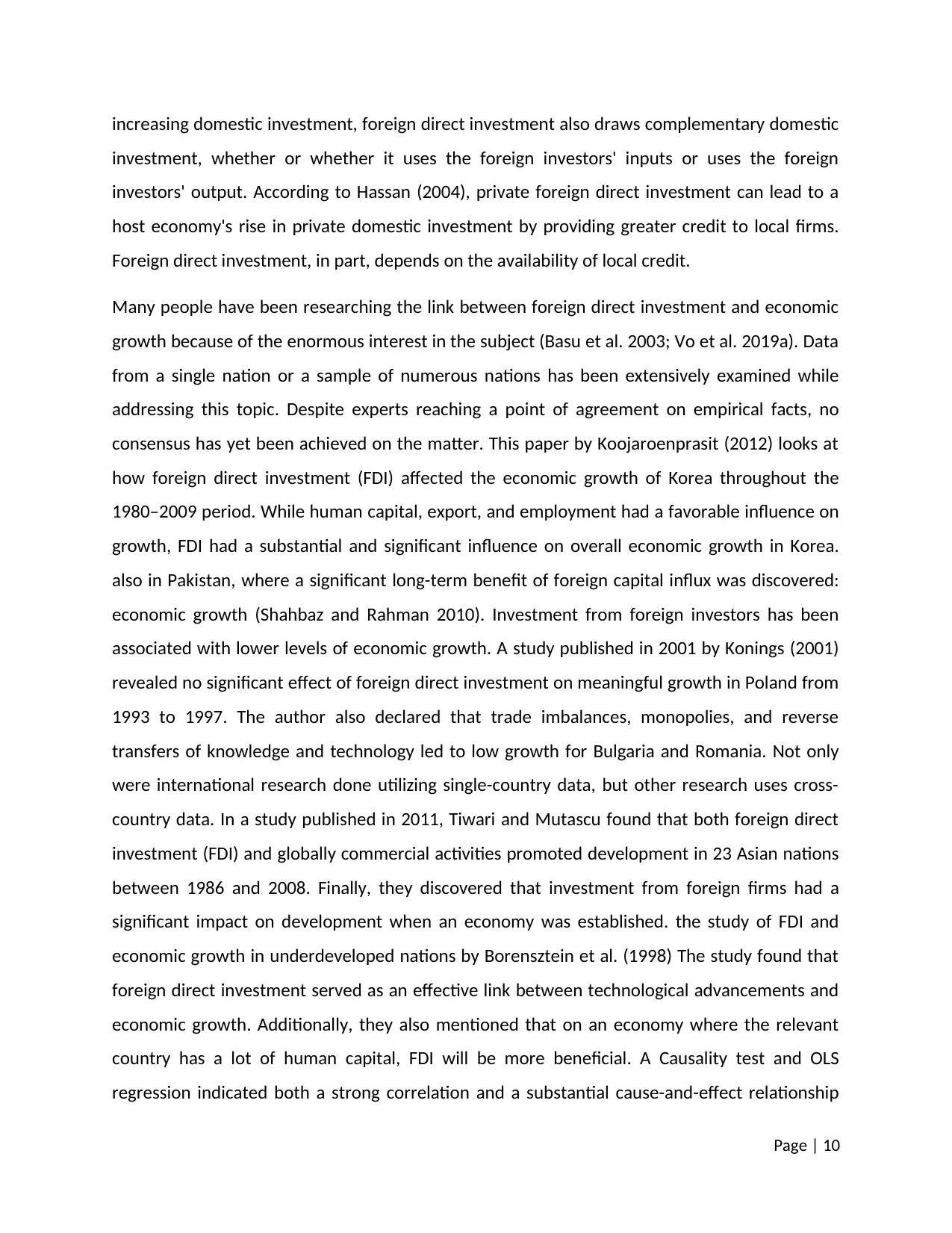
increasing domestic investment, foreign direct investment also draws complementary domestic
investment, whether or whether it uses the foreign investors' inputs or uses the foreign
investors' output. According to Hassan (2004), private foreign direct investment can lead to a
host economy's rise in private domestic investment by providing greater credit to local firms.
Foreign direct investment, in part, depends on the availability of local credit.
Many people have been researching the link between foreign direct investment and economic
growth because of the enormous interest in the subject (Basu et al. 2003; Vo et al. 2019a). Data
from a single nation or a sample of numerous nations has been extensively examined while
addressing this topic. Despite experts reaching a point of agreement on empirical facts, no
consensus has yet been achieved on the matter. This paper by Koojaroenprasit (2012) looks at
how foreign direct investment (FDI) affected the economic growth of Korea throughout the
1980–2009 period. While human capital, export, and employment had a favorable influence on
growth, FDI had a substantial and significant influence on overall economic growth in Korea.
also in Pakistan, where a significant long-term benefit of foreign capital influx was discovered:
economic growth (Shahbaz and Rahman 2010). Investment from foreign investors has been
associated with lower levels of economic growth. A study published in 2001 by Konings (2001)
revealed no significant effect of foreign direct investment on meaningful growth in Poland from
1993 to 1997. The author also declared that trade imbalances, monopolies, and reverse
transfers of knowledge and technology led to low growth for Bulgaria and Romania. Not only
were international research done utilizing single-country data, but other research uses cross-
country data. In a study published in 2011, Tiwari and Mutascu found that both foreign direct
investment (FDI) and globally commercial activities promoted development in 23 Asian nations
between 1986 and 2008. Finally, they discovered that investment from foreign firms had a
significant impact on development when an economy was established. the study of FDI and
economic growth in underdeveloped nations by Borensztein et al. (1998) The study found that
foreign direct investment served as an effective link between technological advancements and
economic growth. Additionally, they also mentioned that on an economy where the relevant
country has a lot of human capital, FDI will be more beneficial. A Causality test and OLS
regression indicated both a strong correlation and a substantial cause-and-effect relationship
Page | 10
investment, whether or whether it uses the foreign investors' inputs or uses the foreign
investors' output. According to Hassan (2004), private foreign direct investment can lead to a
host economy's rise in private domestic investment by providing greater credit to local firms.
Foreign direct investment, in part, depends on the availability of local credit.
Many people have been researching the link between foreign direct investment and economic
growth because of the enormous interest in the subject (Basu et al. 2003; Vo et al. 2019a). Data
from a single nation or a sample of numerous nations has been extensively examined while
addressing this topic. Despite experts reaching a point of agreement on empirical facts, no
consensus has yet been achieved on the matter. This paper by Koojaroenprasit (2012) looks at
how foreign direct investment (FDI) affected the economic growth of Korea throughout the
1980–2009 period. While human capital, export, and employment had a favorable influence on
growth, FDI had a substantial and significant influence on overall economic growth in Korea.
also in Pakistan, where a significant long-term benefit of foreign capital influx was discovered:
economic growth (Shahbaz and Rahman 2010). Investment from foreign investors has been
associated with lower levels of economic growth. A study published in 2001 by Konings (2001)
revealed no significant effect of foreign direct investment on meaningful growth in Poland from
1993 to 1997. The author also declared that trade imbalances, monopolies, and reverse
transfers of knowledge and technology led to low growth for Bulgaria and Romania. Not only
were international research done utilizing single-country data, but other research uses cross-
country data. In a study published in 2011, Tiwari and Mutascu found that both foreign direct
investment (FDI) and globally commercial activities promoted development in 23 Asian nations
between 1986 and 2008. Finally, they discovered that investment from foreign firms had a
significant impact on development when an economy was established. the study of FDI and
economic growth in underdeveloped nations by Borensztein et al. (1998) The study found that
foreign direct investment served as an effective link between technological advancements and
economic growth. Additionally, they also mentioned that on an economy where the relevant
country has a lot of human capital, FDI will be more beneficial. A Causality test and OLS
regression indicated both a strong correlation and a substantial cause-and-effect relationship
Page | 10
Paraphrase This Document
Need a fresh take? Get an instant paraphrase of this document with our AI Paraphraser

between FDI and economic growth for Arab nations in the book 'Omran and Bolbol (2003). They
also found that the addition of a wide range of other local and external factors, coupled with
attraction focused FDI policies, played a substantial role in FDI inflows. FDI was a key
contributor to 20 OECD nations' development, according to Alfaro et al. (2004). They also found
that the financial market's level of development affected FDI and GDP growth. Basu et al.
(2003) researched the relationship between foreign direct investment (FDI) and economic
development in 23 developing countries from 1978 to 1996. After controlling for country-
specific impacts, FDI and economic growth appear to move together in the long-term. These
findings reveal a bidirectional relationship between GDP and FDI in nations with a higher level
of economic openness, whereas a unidirectional relationship exists between GDP and FDI in
those economies that are closed. In contrast to the positive link discovered between foreign
direct investment (FDI) and national growth on a cross-country basis, a negative association was
observed, which is one of the primary problems that remain to be solved. According to the
study by Jyun-Yi and Chih-Chiang (2008), there was no association between foreign direct
investment and economic development for 62 countries between 1975 and 2000. FDI did not
affect economic growth in emerging markets in developing nations between 1995–1998, as
previously reported by Lyroudi et al. (2004). Within the last decade, a new and increasing body
of literature has emerged focused on the link between foreign direct investment and
output/consumption volatility (Backus et al. 1992; Bodenstein 2008; Caporale et al. 2015;
Levchenko 2005). Financial openness was seen as increasing over time and positively linked to
increased consumption volatility in developing nations from 1960 to 1999, according to the
findings of Kose et al. (2003). Kose et al. (2009) explored how the benefits of financial
globalization have been distributed across nations. In contrast to emerging markets, where the
risk is not shared by developed nations, developed nations have seen an increase in risk sharing
relative to the global economy.
Externalities arising from foreign direct investment are discovered in a study conducted by Ping
et al., (2019). In the first channel, foreign enterprises join the local market to compete with the
locals. Because of the increasing rivalry, manufacturing may become more efficient,
productivity might rise, and physical capital investment may grow. Thus, increasing the quality
Page | 11
also found that the addition of a wide range of other local and external factors, coupled with
attraction focused FDI policies, played a substantial role in FDI inflows. FDI was a key
contributor to 20 OECD nations' development, according to Alfaro et al. (2004). They also found
that the financial market's level of development affected FDI and GDP growth. Basu et al.
(2003) researched the relationship between foreign direct investment (FDI) and economic
development in 23 developing countries from 1978 to 1996. After controlling for country-
specific impacts, FDI and economic growth appear to move together in the long-term. These
findings reveal a bidirectional relationship between GDP and FDI in nations with a higher level
of economic openness, whereas a unidirectional relationship exists between GDP and FDI in
those economies that are closed. In contrast to the positive link discovered between foreign
direct investment (FDI) and national growth on a cross-country basis, a negative association was
observed, which is one of the primary problems that remain to be solved. According to the
study by Jyun-Yi and Chih-Chiang (2008), there was no association between foreign direct
investment and economic development for 62 countries between 1975 and 2000. FDI did not
affect economic growth in emerging markets in developing nations between 1995–1998, as
previously reported by Lyroudi et al. (2004). Within the last decade, a new and increasing body
of literature has emerged focused on the link between foreign direct investment and
output/consumption volatility (Backus et al. 1992; Bodenstein 2008; Caporale et al. 2015;
Levchenko 2005). Financial openness was seen as increasing over time and positively linked to
increased consumption volatility in developing nations from 1960 to 1999, according to the
findings of Kose et al. (2003). Kose et al. (2009) explored how the benefits of financial
globalization have been distributed across nations. In contrast to emerging markets, where the
risk is not shared by developed nations, developed nations have seen an increase in risk sharing
relative to the global economy.
Externalities arising from foreign direct investment are discovered in a study conducted by Ping
et al., (2019). In the first channel, foreign enterprises join the local market to compete with the
locals. Because of the increasing rivalry, manufacturing may become more efficient,
productivity might rise, and physical capital investment may grow. Thus, increasing the quality
Page | 11
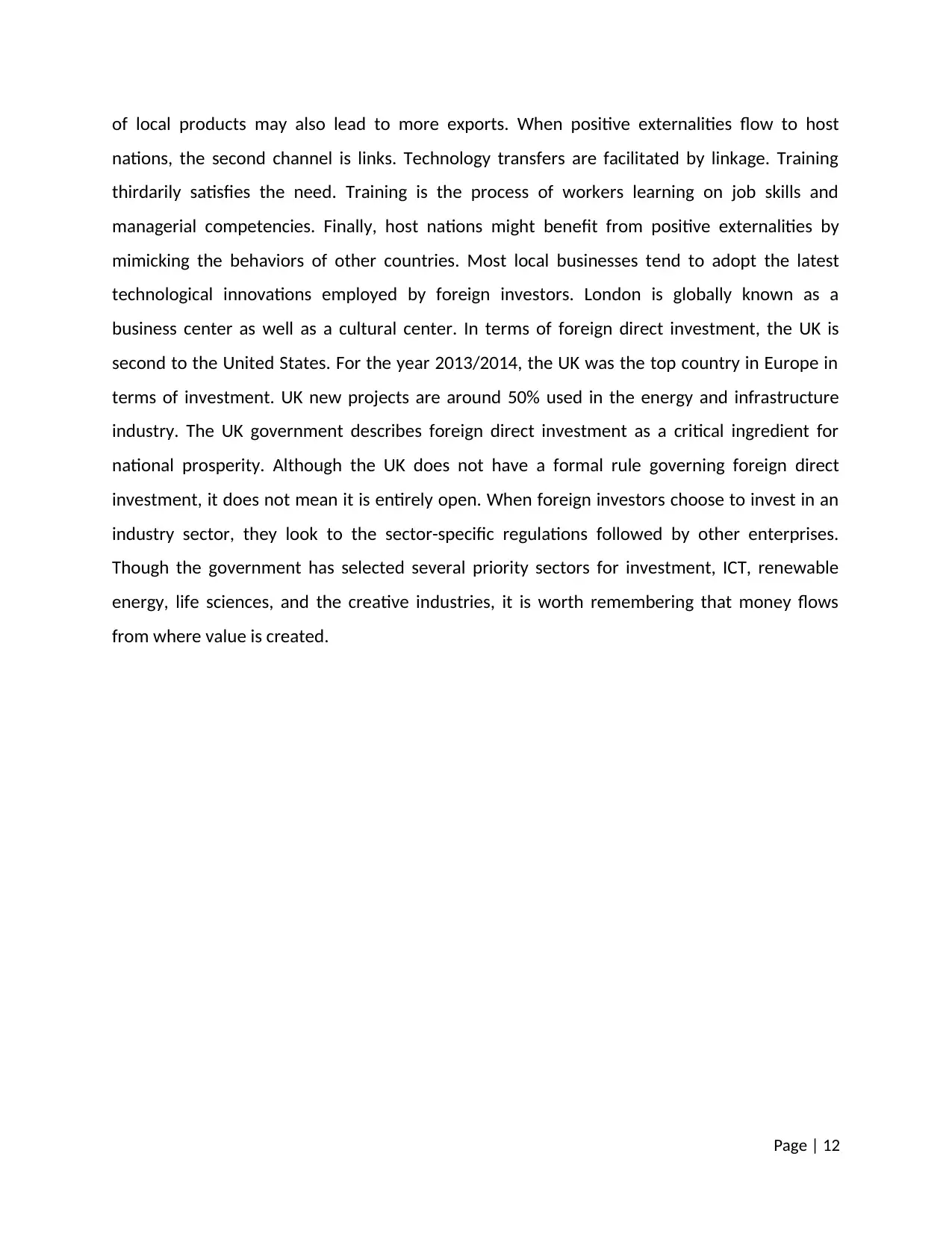
of local products may also lead to more exports. When positive externalities flow to host
nations, the second channel is links. Technology transfers are facilitated by linkage. Training
thirdarily satisfies the need. Training is the process of workers learning on job skills and
managerial competencies. Finally, host nations might benefit from positive externalities by
mimicking the behaviors of other countries. Most local businesses tend to adopt the latest
technological innovations employed by foreign investors. London is globally known as a
business center as well as a cultural center. In terms of foreign direct investment, the UK is
second to the United States. For the year 2013/2014, the UK was the top country in Europe in
terms of investment. UK new projects are around 50% used in the energy and infrastructure
industry. The UK government describes foreign direct investment as a critical ingredient for
national prosperity. Although the UK does not have a formal rule governing foreign direct
investment, it does not mean it is entirely open. When foreign investors choose to invest in an
industry sector, they look to the sector-specific regulations followed by other enterprises.
Though the government has selected several priority sectors for investment, ICT, renewable
energy, life sciences, and the creative industries, it is worth remembering that money flows
from where value is created.
Page | 12
nations, the second channel is links. Technology transfers are facilitated by linkage. Training
thirdarily satisfies the need. Training is the process of workers learning on job skills and
managerial competencies. Finally, host nations might benefit from positive externalities by
mimicking the behaviors of other countries. Most local businesses tend to adopt the latest
technological innovations employed by foreign investors. London is globally known as a
business center as well as a cultural center. In terms of foreign direct investment, the UK is
second to the United States. For the year 2013/2014, the UK was the top country in Europe in
terms of investment. UK new projects are around 50% used in the energy and infrastructure
industry. The UK government describes foreign direct investment as a critical ingredient for
national prosperity. Although the UK does not have a formal rule governing foreign direct
investment, it does not mean it is entirely open. When foreign investors choose to invest in an
industry sector, they look to the sector-specific regulations followed by other enterprises.
Though the government has selected several priority sectors for investment, ICT, renewable
energy, life sciences, and the creative industries, it is worth remembering that money flows
from where value is created.
Page | 12
⊘ This is a preview!⊘
Do you want full access?
Subscribe today to unlock all pages.

Trusted by 1+ million students worldwide
1 out of 21